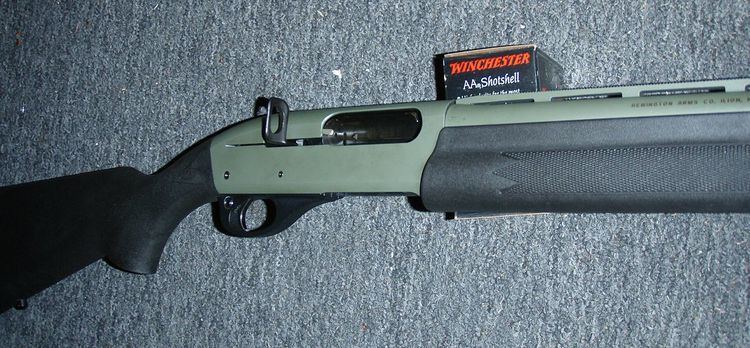Used by See Users | Designer Wayne Leek Produced 1963–present | |
 | ||
The Remington 1100 is a gas-operated semi-automatic shotgun, popular among sportsmen. The Remington 1100 was the first semiautomatic shotgun to feature significant improvements in felt recoil, weight and reliability.
Contents
History
Designed by Wayne Leek, the Remington Model 1100 was introduced in 1963 as a successor to the Model 58 and 878 gas operated shotguns. The Model 58s had supplanted the recoil operated Model 11-48, which retained the long recoil action of John Browning's original design, present in the Remington Model 11 and the Auto-5. All models of the 1100 are gas operated with a mechanism that noticeably reduces recoil. Several variations of the Model 1100, in 12, 20, and 28 gauges, and .410 bore are still in production as of 2016. The Remington Model 1100 ushered in the era of successful and reliable gas-actuated autoloading shotguns, and, as of 1983, it was the best selling autoloading shotgun in U.S. history, in dollar terms. Over 4 million have been produced. The Model 1100 holds the record for the most shells fired out of an autoloading shotgun without malfunction, cleaning or parts breakage with a record of over 24,000 rounds. The record was set in 1978 with a Remington model 1100 LT-20. Breaking this record has been attempted with several other models of semi-auto shotguns but has yet to be broken. In 2011 Remington introduced the Model 1100 Competition Synthetic. A 50th Anniversary highly decorated version was introduced in 2013.
A "plain jane" version, named the Remington Sportsman 12 Auto, was sold in stores like Target, K-Mart, and WalMart in the mid 1980s, along with a Sportsman 12 Pump, which was a "plain jane" Remington 870. This was exactly the same gun as the 1100 in 12 Gauge, but with less costly birch stocks, and less rollmarking on the gun's receiver. These were simply cosmetic differences, however, and all 1100 parts in 12 Gauge fully interchange, including barrels and receivers. Both the Sportsman Auto and the Pump were discontinued in 1987, concurrent with the introduction of the Remington 11-87 semi auto and the 870 Express pump model.
Design
The Model 1100 bleeds off gasses to operate the action through ports in the barrel near the end of the fore end. The gasses then drive a steel action sleeve that fits around the magazine tube and connects to the bolt carrier to the rear, ejecting the spent shell. A fresh shell is released from the magazine, which trips the carrier release, and the action spring in the stock pushes the bolt forward, picking up the fresh shell and loading it into the chamber. With modifications to the trigger group to regulate feed and firing, the design is basically a gas powered Model 870. The design team spent many hundreds of hours test firing and getting input from shooters on the design before it was released for production. The fact that plastic shotshells had come onto the scene, and even the older paper shells were carrying improved coatings, made for more reliable ammunition, which no doubt assisted the 1100 to become a true breakthrough in gas operated shotgun reliability. The design was self-compensating to an extent not seen previously, in that any 2-3/4" shell could be fired without adjustment in the standard models, and both 2-3/4" and 3" Magnum shells could be used interchangeably on the Magnum versions. The Remington 1100’s carrier release is located on the underside of the firearm which is unlike a number of other semi-automatic shotguns such as the Mossberg 930 or the FN SLP whose carrier releases are located on the side.
Use
The Remington 1100 was an immediate hit upon its introduction. It quickly became "the gun" on the Skeet ranges in the days before the over and under came to prominence. It was employed by hunters pursuing almost any game that could be pursued with a shotgun, and the 3" Magnum models found favor as waterfowling guns. The 1100 is a popular gun used in trap shooting, skeet shooting, and sporting clays; and special versions with high ribs and Monte Carlo stocks are available. The Competition Synthetic model with an adjustable carbon fibre stock set was introduced in 2012 and has been received quite favorably. As with other semi-automatic shotguns, a shell catcher can be used to avoid spent shells hitting others on the squad when shooting trap. Modified versions of the 1100 are popular in tactical three-gun shooting as well.
Model introduction
Through the years there have been numerous limited editions and Commemorative models, such as the Ducks Unlimited guns.
Nighthawk Custom offers a customized version of the Remington 1100 for police use, home defense, and competition shooting.
